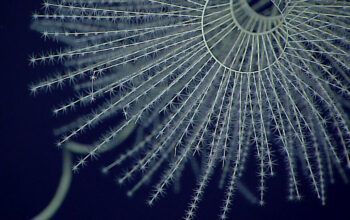
When choosing between life and limb, many animals willingly sacrifice the limb. The ability to drop appendages is known as autotomy, or self-amputation. When backed into a corner, spiders let go of legs, crabs drop claws and some small rodents shed clumps of skin. Some sea slugs will even decapitate themselves to rid themselves of their parasite-infested bodies.
But lizards may be the best-known users of autotomy. To evade predators, many lizards ditch their still-wiggling tails. This behavior confounds the predator, buying the rest of the lizard time to scurry away. While there are drawbacks to losing a tail — they come in handy for maneuvering, impressing mates and storing fat — it beats being eaten. Many lizards are even capable of regenerating lost tails.
Scientists have studied this anti-predator behavior meticulously, but the structures that make it work remain puzzling. If a lizard can shed its tail in an instant, what keeps it attached in non-life-threatening situations?
Yong-Ak Song, a biomechanical engineer at New York University Abu Dhabi, calls this the “paradox of the tail”: It must be simultaneously adherent and detachable. “It has to detach its tail quickly in order to survive,” Dr. Song said of the lizard. “But at the same time, it cannot lose its tail too easily.”
Recently, Dr. Song and his colleagues sought to solve the paradox by examining several freshly amputated tails. They did not want for test subjects — according to Dr. Song, the N.Y.U. Abu Dhabi campus is crawling with geckos. Using tiny loops attached to fishing rods, they rounded up several lizards from three species: two types of geckos and a desert lizard known as Schmidt’s fringe-toed lizard.
Back at the lab, they pulled the lizards’ tails with their fingers, coaxing them into acts of autotomy. They filmed the resulting process at 3,000 frames per second using a high-speed camera. (The lizards were soon returned to where they were first found.) Then the scientists stuck the squirming tails under an electron microscope.
At a microscopic scale, they could see that each fracture where the tail had detached from the body was brimming with mushroom-shaped pillars. Zooming in even more, they saw that each mushroom cap was dotted with tiny pores. The team was surprised to find that instead of parts of the tail interlocking along the fracture planes, the dense pockets of micropillars on each segment appeared to touch only lightly. This made the lizard tail seem like a brittle constellation of loosely connected segments.
However, computer modeling of the tail fracture planes revealed that the mushroomlike microstructures were adept at releasing built-up energy. One reason is that they are filled with minuscule gaps, like tiny pores and spaces between each mushroom cap. These voids absorb the energy from a tug, keeping the tail intact.
While these microstructures can withstand pulling, the team found that they were susceptible to splintering from a slight twist. They determined that the tails were 17 times more likely to fracture from bending than from being pulled. In the slow-motion videos the researchers took, the lizards twisted their tails to cleanly cleave them in two along the fleshy fracture plane.
Their findings, published Thursday in the journal Science, illustrate how these tails hit the perfect balance between firm and fragile. “It’s a beautiful example of the Goldilocks principle applied to a model in nature,” Dr. Song said.
According to Animangsu Ghatak, a chemical engineer at the Indian Institute of Technology Kanpur, the biomechanics of these lizard’s tails are reminiscent of the sticky microstructures found on the tacky toes of geckos and tree frogs. “It has to be just the right balance between adhesion and detachment, because that allows these animals to scale steep surfaces,” said Dr. Ghatak, who was not involved in the study. He added that the animals’ feet were covered in billions of tiny bristles which themselves were composed of mushroom-shaped caps.
The researchers believe that understanding the process that lets lizards dump their tails could have uses for attaching prosthetics, skin grafts or bandages, and may even help robots shed broken parts.
However, Dr. Song is most excited to finally understand how the creatures on campus escape predators.
“This project was completely curiosity-driven,” he said. “We just simply wanted to know how the lizards around us cut their tails off so quickly.”



